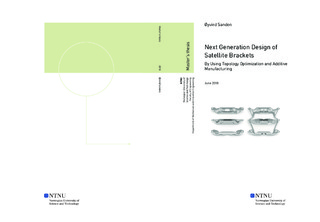| dc.contributor.advisor | Torgersen, Jan | |
| dc.contributor.advisor | Berto, Filippo | |
| dc.contributor.author | Sanden, Øyvind | |
| dc.date.accessioned | 2019-09-11T09:10:51Z | |
| dc.date.created | 2018-06-10 | |
| dc.date.issued | 2018 | |
| dc.identifier | ntnudaim:19780 | |
| dc.identifier.uri | http://hdl.handle.net/11250/2615331 | |
| dc.description.abstract | This thesis has explored how topology optimization and additive manufacturing can
be used to improve the resonance performance of existing mechanical components.
By using a sensitivity-based optimization algorithm for minimum compliance, the
resulting optimized components show an increased natural frequency compared
to the original components. Three brackets holding the payload of the AISSat
1 satellite were used as baseline components. Two different design optimizations
were performed. In the first result, each bracket was optimized individually, while
the second result combined the three brackets into one component. The natural
frequency of the original center bracket was increased from 3224 Hz to 3849 Hz and
the top and bottom brackets increased from 2667 Hz to 4138 Hz. The one-piece
bracket achieved a natural frequency of 3795 Hz. A weight target of 36 grams based
on the total weight of the original brackets was used. This target was not met by
either result. The individual brackets amassed to a total of 43.4 grams, while the
one-piece bracket weighed 39.9 grams. | en |
| dc.language | eng | |
| dc.publisher | NTNU | |
| dc.subject | Produktutvikling og produksjon, Produktutvikling | en |
| dc.title | Next Generation Design of Satellite Brackets - By Using Topology Optimization and Additive Manufacturing | en |
| dc.type | Master thesis | en |
| dc.source.pagenumber | 114 | |
| dc.contributor.department | Norges teknisk-naturvitenskapelige universitet, Fakultet for ingeniørvitenskap,Institutt for maskinteknikk og produksjon | nb_NO |
| dc.date.embargoenddate | 2021-06-10 | |

